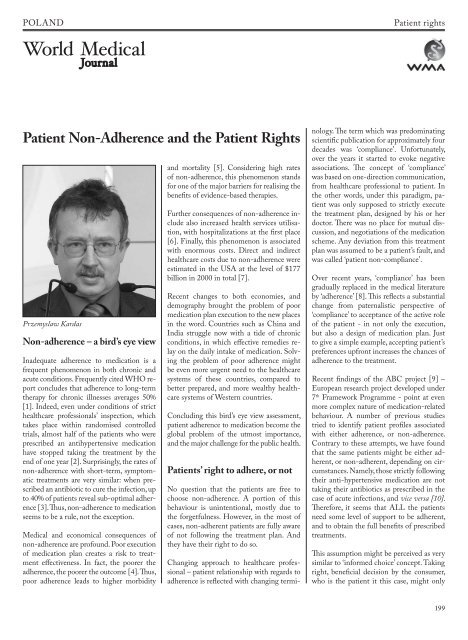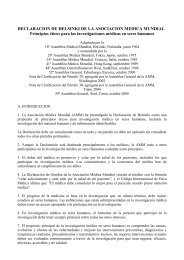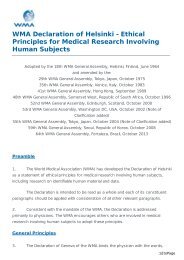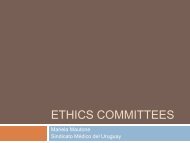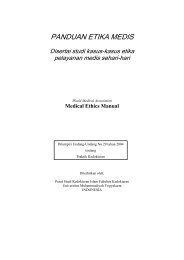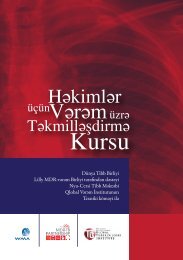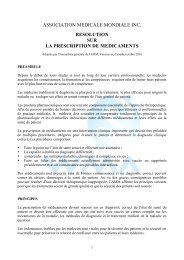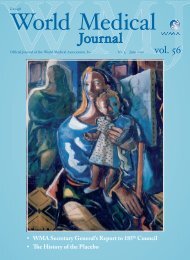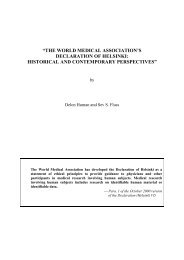WMJ 05 2011 - World Medical Association
WMJ 05 2011 - World Medical Association
WMJ 05 2011 - World Medical Association
Create successful ePaper yourself
Turn your PDF publications into a flip-book with our unique Google optimized e-Paper software.
POLAND<br />
Patient rights<br />
Patient Non-Adherence and the Patient Rights<br />
Przemyslaw Kardas<br />
Non-adherence – a bird’s eye view<br />
Inadequate adherence to medication is a<br />
frequent phenomenon in both chronic and<br />
acute conditions. Frequently cited WHO report<br />
concludes that adherence to long-term<br />
therapy for chronic illnesses averages 50%<br />
[1]. Indeed, even under conditions of strict<br />
healthcare professionals’ inspection, which<br />
takes place within randomised controlled<br />
trials, almost half of the patients who were<br />
prescribed an antihypertensive medication<br />
have stopped taking the treatment by the<br />
end of one year [2]. Surprisingly, the rates of<br />
non-adherence with short-term, symptomatic<br />
treatments are very similar: when prescribed<br />
an antibiotic to cure the infection, up<br />
to 40% of patients reveal sub-optimal adherence<br />
[3]. Thus, non-adherence to medication<br />
seems to be a rule, not the exception.<br />
<strong>Medical</strong> and economical consequences of<br />
non-adherence are profound. Poor execution<br />
of medication plan creates a risk to treatment<br />
effectiveness. In fact, the poorer the<br />
adherence, the poorer the outcome [4]. Thus,<br />
poor adherence leads to higher morbidity<br />
and mortality [5]. Considering high rates<br />
of non-adherence, this phenomenon stands<br />
for one of the major barriers for realising the<br />
benefits of evidence-based therapies.<br />
Further consequences of non-adherence include<br />
also increased health services utilisation,<br />
with hospitalizations at the first place<br />
[6]. Finally, this phenomenon is associated<br />
with enormous costs. Direct and indirect<br />
healthcare costs due to non-adherence were<br />
estimated in the USA at the level of $177<br />
billion in 2000 in total [7].<br />
Recent changes to both economies, and<br />
demography brought the problem of poor<br />
medication plan execution to the new places<br />
in the word. Countries such as China and<br />
India struggle now with a tide of chronic<br />
conditions, in which effective remedies relay<br />
on the daily intake of medication. Solving<br />
the problem of poor adherence might<br />
be even more urgent need to the healthcare<br />
systems of these countries, compared to<br />
better prepared, and more wealthy healthcare<br />
systems of Western countries.<br />
Concluding this bird’s eye view assessment,<br />
patient adherence to medication become the<br />
global problem of the utmost importance,<br />
and the major challenge for the public health.<br />
Patients’ right to adhere, or not<br />
No question that the patients are free to<br />
choose non-adherence. A portion of this<br />
behaviour is unintentional, mostly due to<br />
the forgetfulness. However, in the most of<br />
cases, non-adherent patients are fully aware<br />
of not following the treatment plan. And<br />
they have their right to do so.<br />
Changing approach to healthcare professional<br />
– patient relationship with regards to<br />
adherence is reflected with changing terminology.<br />
The term which was predominating<br />
scientific publication for approximately four<br />
decades was ‘compliance’. Unfortunately,<br />
over the years it started to evoke negative<br />
associations. The concept of ‘compliance’<br />
was based on one-direction communication,<br />
from healthcare professional to patient. In<br />
the other words, under this paradigm, patient<br />
was only supposed to strictly execute<br />
the treatment plan, designed by his or her<br />
doctor. There was no place for mutual discussion,<br />
and negotiations of the medication<br />
scheme. Any deviation from this treatment<br />
plan was assumed to be a patient’s fault, and<br />
was called ‘patient non-compliance’.<br />
Over recent years, ‘compliance’ has been<br />
gradually replaced in the medical literature<br />
by ‘adherence’ [8]. This reflects a substantial<br />
change from paternalistic perspective of<br />
‘compliance’ to acceptance of the active role<br />
of the patient - in not only the execution,<br />
but also a design of medication plan. Just<br />
to give a simple example, accepting patient’s<br />
preferences upfront increases the chances of<br />
adherence to the treatment.<br />
Recent findings of the ABC project [9] –<br />
European research project developed under<br />
7 th Framework Programme - point at even<br />
more complex nature of medication-related<br />
behaviour. A number of previous studies<br />
tried to identify patient profiles associated<br />
with either adherence, or non-adherence.<br />
Contrary to these attempts, we have found<br />
that the same patients might be either adherent,<br />
or non-adherent, depending on circumstances.<br />
Namely, those strictly following<br />
their anti-hypertensive medication are not<br />
taking their antibiotics as prescribed in the<br />
case of acute infections, and vice versa [10].<br />
Therefore, it seems that ALL the patients<br />
need some level of support to be adherent,<br />
and to obtain the full benefits of prescribed<br />
treatments.<br />
This assumption might be perceived as very<br />
similar to ‘informed choice’ concept. Taking<br />
right, beneficial decision by the consumer,<br />
who is the patient it this case, might only<br />
199


